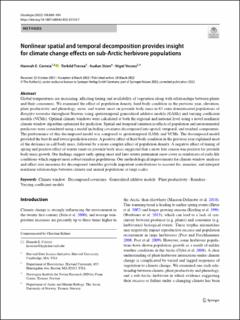| dc.contributor.author | Correia, Hannah E. | |
| dc.contributor.author | Tveraa, Torkild | |
| dc.contributor.author | Stien, Audun | |
| dc.contributor.author | Yoccoz, Nigel | |
| dc.coverage.spatial | Norway | en_US |
| dc.date.accessioned | 2023-01-25T07:54:26Z | |
| dc.date.available | 2023-01-25T07:54:26Z | |
| dc.date.created | 2022-04-26T11:40:23Z | |
| dc.date.issued | 2022 | |
| dc.identifier.citation | Oecologia. 2022, 198 889-904. | en_US |
| dc.identifier.issn | 0029-8549 | |
| dc.identifier.uri | https://hdl.handle.net/11250/3046048 | |
| dc.description.abstract | Global temperatures are increasing, afecting timing and availability of vegetation along with relationships between plants and their consumers. We examined the efect of population density, herd body condition in the previous year, elevation, plant productivity and phenology, snow, and winter onset on juvenile body mass in 63 semi-domesticated populations of Rangifer tarandus throughout Norway using spatiotemporal generalized additive models (GAMs) and varying coefcient models (VCMs). Optimal climate windows were calculated at both the regional and national level using a novel nonlinear climate window algorithm optimized for prediction. Spatial and temporal variation in efects of population and environmental predictors were considered using a model including covariates decomposed into spatial, temporal, and residual components. The performance of this decomposed model was compared to spatiotemporal GAMs and VCMs. The decomposed model provided the best ft and lowest prediction errors. A positive efect of herd body condition in the previous year explained most of the deviance in calf body mass, followed by a more complex efect of population density. A negative efect of timing of spring and positive efect of winter onset on juvenile body mass suggested that a snow free season was positive for juvenile body mass growth. Our fndings suggest early spring onset and later winter permanent snow cover as reinforcers of early-life conditions which support more robust reindeer populations. Our methodological improvements for climate window analyses and efect size measures for decomposed variables provide important contributions to account for, measure, and interpret nonlinear relationships between climate and animal populations at large scales. Climate window · Decomposed covariates · Generalized additive models · Plant productivity · Reindeer · Varying coefcient models | en_US |
| dc.language.iso | eng | en_US |
| dc.rights | Navngivelse 4.0 Internasjonal | * |
| dc.rights.uri | http://creativecommons.org/licenses/by/4.0/deed.no | * |
| dc.subject | Climate window | en_US |
| dc.subject | Decomposed covariates | en_US |
| dc.subject | Generalized additive models | en_US |
| dc.subject | Plant productivity | en_US |
| dc.subject | Reindeer | en_US |
| dc.subject | Varying coefcient models | en_US |
| dc.title | Nonlinear spatial and temporal decomposition provides insight for climate change effects on sub-Arctic herbivore populations | en_US |
| dc.title.alternative | Nonlinear spatial and temporal decomposition provides insight for climate change effects on sub-Arctic herbivore populations | en_US |
| dc.type | Peer reviewed | en_US |
| dc.type | Journal article | en_US |
| dc.description.version | publishedVersion | en_US |
| dc.rights.holder | © 2022 The Authors | en_US |
| dc.subject.nsi | VDP::Zoologiske og botaniske fag: 480 | en_US |
| dc.subject.nsi | VDP::Zoology and botany: 480 | en_US |
| dc.source.pagenumber | 889-904 | en_US |
| dc.source.volume | 198 | en_US |
| dc.source.journal | Oecologia | en_US |
| dc.identifier.doi | 10.1007/s00442-022-05150-7 | |
| dc.identifier.cristin | 2019153 | |
| dc.relation.project | Norges forskningsråd: 276395 | en_US |
| cristin.ispublished | true | |
| cristin.fulltext | original | |
| cristin.qualitycode | 2 | |

